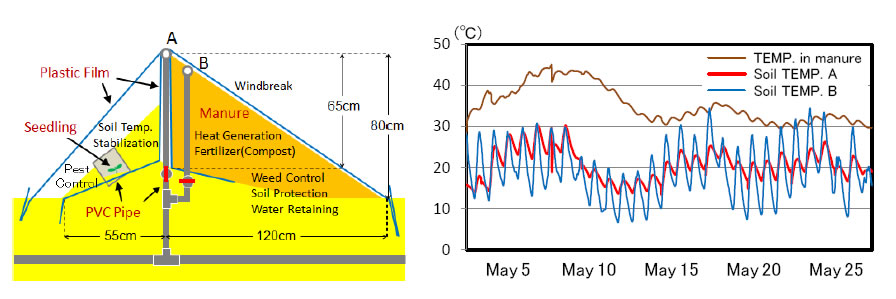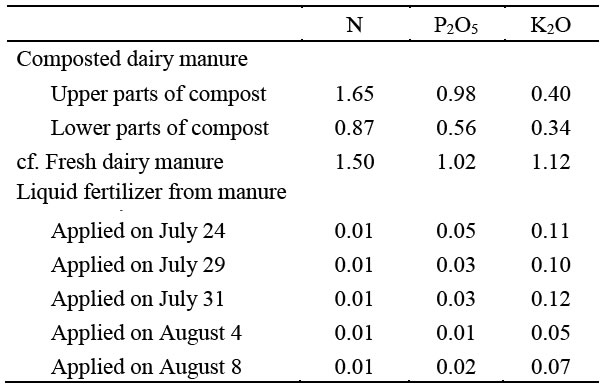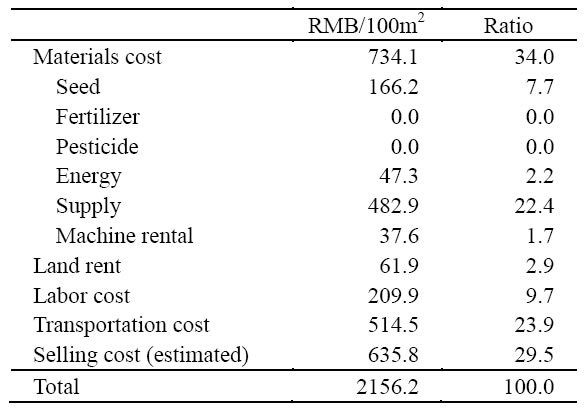The effectiveness of introducing organic vegetable cultivation to the small-sized dairy farms in the semi-arid regions, China
Description
The cost of feed grains had risen precipitously in recent years; it resulted in a critical situation for the viability of the small-sized dairy farms in the semi-arid regions, China. In order to deal with this problem, some of the dairy farmers have started planning to independently grow corn by using dairy manure as fertilizer. It must occur however to waste water resources by extensive farming and to increase wind erosion phenomena in soil condition improved by manure.
Cultivating organic vegetables as high value added products is an effective method against feed grain price rise and for sustainable dairy farming, but it is necessary for dairy farmers living in the regions far away from market to introduce the cost-saving and labor-saving cultivation system. Because only 11.9% of the consumers were willing to pay over twice as much for organic vegetables as for vegetables produced in conventional farming practice, when we conducted a survey in which 1,200 consumers from four large cities (Beijing, Shanghai, Guangzhou and Ha’erbin) were asked how much they would be willing to pay for organic vegetables.
We have introduced a low cost multifunctional system utilizing regional resources for cultivating organic vegetables in Suniteyouqi, Inner Mongolia (Fig.1); for example, heat released from fermenting manure promotes germination of vegetable seeds; barrier of piled manure protects seedlings, which have just sprouted, from strong wind; and PVC pipe prevents cutworms from damaging the plants. This cultivation system provides cost-saving without building a greenhouse for raising seedling and planting a forest for windbreak; and also results in labor-saving not to constitute an additional heavy burden on dairy farmers in only switching irrigation pump on-off as daily operation.
We have cultivated 170 plants of mini pumpkin (Beibei) in 500m2 experimental field, and have harvested 993.0kg (9pieces per plant, 649g per piece in average) by using composted dairy manure and liquid fertilizer in 2012 (Table 1). The mini pumpkins harvested in 2012 and 2013 have been provided to the consumers through the producing and selling organic vegetable company in Beijing, and 65.8% of the consumers are willing to pay more than 16.0 RMB/kg. The income derived from cultivating mini pumpkins can be evaluated by this willingness to pay and the production and marketing costs for organic mini pumpkins (Table 2); that is, 1021.4RMB/100m2 as the effectiveness of introducing organic vegetable cultivation.
The significant points to consider when introducing this system are to control the irrigation water delivered on dairy manure under the toxic level of sodium for plants and to adopt a monitoring system at low cost for providing information about the organic farming practice to customers.
Figure, table
-
Fig. 1. Multifunctional vegetable cultivation system utilizing dairy manure
To minimize the effects of strong winds in spring the system should be built against west-northwest, which is the direction of the heavy winds in Suniteyouqi, Inner Mongolia.
* Vegetable plants will be supplied fresh water when the valve of pipe A is opened, and will be applied liquid fertilizer through fermented manure when the valve of pipe B is opened.
* In graph, Soil TEMP. A is the temperature at 5cm below the surface of the nursery in the system and Soil TEMP. B is the temperature at 5cm below the surface of the ground outside the system. -
Table 1. Components of dairy manure as a fertilizer resource (%)
* Only 5 date, which were measurable in amount, were presented in this table, though liquid fertilizer was applied 18 times during cultivating mini pumpkins.
-
Table 2. Production and selling cost of mini pumpkins
* Expected earnings (RMB/100m2) can be calculated as (Expected selling price x Quantity – Total cost); that is, 16.0RMB/kg x 198.6kg/100m2 – 2156.2RMB/100m2 = 1021.4RMB/100m2 .
- Affiliation
-
Japan International Research Center for Agricultural Sciences Social Sciences Division
- Classification
-
Research B
- Research project
- Program name
- Term of research
-
FY 2013 (FY 2013-FY 2015)
- Responsible researcher
-
Nakamoto Kazuo ( Social Sciences Division )
MIERUKA ID: 001759Li Ninghui ( Institute of Agricultural Economics and Development, CAAS, China )
Tama ( Institute of Grassland Research, CAAS, China )
Li L. ( Institute of Agricultural Economics and Development, CAAS, China )
- ほか
- Publication, etc.
-
Yang, et al. (2013) Issues in Agricultural Economy 2012 : 159-166.
- Japanese PDF
-
2013_C03_A3_ja.pdf296.49 KB
2013_C03_A4_ja.pdf487.42 KB
- English PDF
-
2013_C03_A3_en.pdf143.3 KB
2013_C03_A4_en.pdf213.11 KB
- Poster PDF
-
2013_C03_poster.pdf315.14 KB



